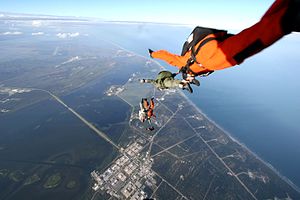920th Rescue Wing
920th Rescue Wing
 |
|
|---|---|

Members of the 920th Rescue Wing conducting freefall training over Cape Canaveral Air Force Station
|
|
| Active | 1963–1965; 1973–1983; 1997–present |
| Country |
|
| Branch |
|
| Type | Wing |
| Role | Air Rescue |
| Size | 1,500 personnel |
| Part of | Air Force Reserve Command |
| Garrison/HQ | Patrick Air Force Base, Florida |
| Decorations | Air Force Outstanding Unit Award |
| Commanders | |
| Current commander |
Colonel Jeffrey L. McCrander |
| Insignia | |
| 920th Rescue Wing emblem (approved 26 September 1984) |  |
| Aircraft flown | |
| Multirole helicopter | HH-60G Pave Hawk |
| Transport | HC-130P/N Hercules |
The 920th Rescue Wing is part of the Air Reserve Component (ARC) of the United States Air Force. The wing is assigned to the Tenth Air Force of the Air Force Reserve Command.
The 920 RQW is home stationed at Patrick Air Force Base, Florida with additional Geographically Separated Units (GSUs) consisting of the 943d Rescue Group at Davis-Monthan Air Force Base, Arizona; the 304th Rescue Squadron at Portland Air National Guard Base, Oregon; and the 920th Aerospace Medicine Flight at Joint Base Langley-Eustis, Virginia. If mobilized to active duty with the Regular Air Force, the 920 RQW is operationally gained by the Air Combat Command (ACC).
Headquartered at Patrick Air Force Base, Florida, the 920th Rescue Wing is the Air Force Reserve Command's premier combat search and rescue (CSAR) unit. The wing consists of over 1,500 Airmen, trained and equipped to locate and recover U.S. Armed Forces personnel during both peacetime and wartime military operations. Additional missions have included manned spaceflight support, such as providing rescue support for NASA Space Shuttle missions during that program's operation; providing search and rescue support for civilians who are lost or in distress; and lending support in humanitarian and disaster relief operations with the wing's HH-60G Pave Hawk and HC-130P/N Hercules aircraft.
In addition to its aircraft squadrons in Florida and Arizona, the wing also has three additional squadrons in Florida, Arizona and Oregon consisting of Combat Rescue Officers (CROs) and enlisted Pararescuemen, the latter known as PJs. While many CROs and PJs enter the 920 RQW from the active duty Air Force, others are accessed directly into the Air Force Reserve. CRO and PJ Candidates must pass a physical assessment test which has about 15% success rate. An average of eighty people Air Force-wide enter the 2-year training program each year.
...
Wikipedia
